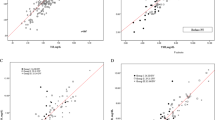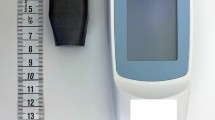Abstract
Objective:
To compare the performance and accuracy of the JM-103 transcutaneous bilirubinometer and Bilistick System in measuring total serum bilirubin for the early identification of neonatal hyperbilirubinemia.
Study Design:
The study was performed on 126 consecutive term and near-term (⩾36 weeks' gestational age) jaundiced newborns in Cairo University Children Hospital NICU, Egypt. Total serum bilirubin was assayed concurrently by the clinical laboratory and Bilistick System and estimated using the JM-103 transcutaneous bilirubin instrument. Bland–Altman analysis was used to evaluate the agreement between determinations.
Result:
The limits of agreement of the Bilistick System (−5.8 to 3.3 mg dl−1) and JM-103 system (−5.4 to 6.0 mg dl−1) versus the clinical laboratory results were similar.
Conclusion:
The Bilistick System is an accurate alternative to transcutaneous (TcB) determination for early diagnosis and proper management of the neonatal jaundice.
This is a preview of subscription content, access via your institution
Access options
Subscribe to this journal
Receive 12 print issues and online access
$259.00 per year
only $21.58 per issue
Buy this article
- Purchase on Springer Link
- Instant access to full article PDF
Prices may be subject to local taxes which are calculated during checkout


Similar content being viewed by others
References
Bhutani VK, Zipursky A, Blencowe H, Khanna R, Sgro M, Ebbesen F et al. Neonatal hyperbilirubinemia and Rhesus disease of the newborn: incidence and impairment estimates for 2010 at regional and global levels. Pediatr Res 2013; 74 (Suppl 1): 86–100.
Maisels MJ . Managing the jaundiced newborn: a persistent challenge. CMAJ 2015; 187 (5): 335–343.
Olusanya BO, Ogunlesi TA, Slusher TM . Why is kernicterus still a major cause of death and disability in low-income and middle-income countries? Arch Dis Child 2014; 99 (12): 1117–1121.
Olusanya BO, Ogunlesi TA, Kumar P, Boo N-Y, Iskander IF, de Almeida MFB et al. Management of late-preterm and term infants with hyperbilirubinaemia in resource-constrained settings. BMC Pediatr 2015; 15: 39.
Hameed NN, Na’ Ma AM, Vilms R, Bhutani VK . Severe neonatal hyperbilirubinemia and adverse short-term consequences in Baghdad. Iraq Neonatol 2011; 100 (1): 57–63.
Brown AK, Damus K, Kim MH, King K, Harper R, Campbell D et al. Factors relating to readmission of term and near-term neonates in the first two weeks of life. Early Discharge Survey Group of the Health Professional Advisory Board of the Greater New York Chapter of the March of Dimes. J Perinat Med 1999; 27 (4): 263–275.
Hemmati F, Kiyani Rad NA . The value of bilicheck as a screening tool for neonatal jaundice in the South of iran. Iran J Med Sci 2013; 38 (2): 122–128.
Bhutani VK, Gourley GR, Adler S, Kreamer B, Dalin C, Johnson LH . Noninvasive measurement of total serum bilirubin in a multiracial predischarge newborn population to assess the risk of severe hyperbilirubinemia. Pediatrics 2000; 106 (2): E17.
Subcommittee on Hyperbilirubinemia. Management of hyperbilirubinemia in the newborn infant 35 or more weeks of gestation. Pediatrics 2004; 114 (1): 297–316.
Ebbesen F, Vandborg PK, Trydal T . Comparison of the transcutaneous bilirubinometers BiliCheck and Minolta JM-103 in preterm neonates. Acta Paediatr 2012; 101 (11): 1128–1133.
Raimondi F, Lama S, Landolfo F, Sellitto M, Borrelli AC, Maffucci R et al. Measuring transcutaneous bilirubin: a comparative analysis of three devices on a multiracial population. BMC Pediatr 2012; 12: 70.
Olusanya BO, Imosemi DO, Emokpae AA . Differences between transcutaneous and serum bilirubin measurements in black African neonates. Pediatrics 2016; 138: 3.
Taylor JA, Burgos AE, Flaherman V, Chung EK, Simpson EA, Goyal NK et al. Discrepancies between transcutaneous and serum bilirubin measurements. Pediatrics 2015; 135 (2): 224–231.
Knüpfer M, Pulzer F, Braun L, Heilmann A, Robel-Tillig E, Vogtmann C . Transcutaneous bilirubinometry in preterm infants. Acta Paediatr 2001; 90 (8): 899–903.
Murli L, Thukral A, Sankar MJ, Vishnubhatla S, Deorari AK, Paul VK et al. Reliability of transcutaneous bilirubinometry from shielded skin in neonates receiving phototherapy: a prospective cohort study. J Perinatol 2016; 37 (2): 182–187.
Coda Zabetta CD, Iskander IF, Greco C, Bellarosa C, Demarini S, Tiribelli C et al. Bilistick: a low-cost point-of-care system to measure total plasma bilirubin. Neonatology 2013; 103 (3): 177–181.
Greco C, Arnolda G, Boo N-Y, Iskander IF, Okolo AA, Rohsiswatmo R et al. Neonatal jaundice in low- and middle-income countries: lessons and future directions from the 2015 Don Ostrow Trieste Yellow Retreat. Neonatology 2016; 110 (3): 172–180.
Gotink MJ, Benders MJ, Lavrijsen SW, Rodrigues Pereira R, Hulzebos CV, Dijk PH . Severe Neonatal Hyperbilirubinemia in the Netherlands. Neonatology 2013; 104 (2): 137–142.
Brown S, Small R, Faber B, Krastev A, Davis P . Early postnatal discharge from hospital for healthy mothers and term infants. Cochrane Database Syst Rev 2002; Issue 3. Art. No.: CD002958.
Iskander I, Gamaleldin R, Kabbani M . Root causes for late presentation of severe neonatal hyperbilirubinaemia in Egypt. East Mediterr Health J 2012; 18 (8): 882–887.
Gamaleldin R, Iskander I, Seoud I, Aboraya H, Aravkin A, Sampson PD et al. Risk factors for neurotoxicity in newborns with severe neonatal hyperbilirubinemia. Pediatrics 2011; 128 (4): e925–e931.
Casnocha Lucanova L, Matasova K, Zibolen M, Krcho P . Accuracy of transcutaneous bilirubin measurement in newborns after phototherapy. J Perinatol 2016; 36 (10): 858–861.
Bland JM, Altman DG . Measuring agreement in method comparison studies. Stat Methods Med Res 1999; 8 (2): 135–160.
Carstensen B. Design of Method Comparison Studies, in Comparing Clinical Measurement Methods: A Practical Guide. John Wiley & Sons, Ltd: Chichester, UK, 2011, pp 127–131..
Allen NM, Mohammad F, Foran A, Corcoran D, Clarke T . Severe hyperbilirubinaemia and kernicterus: more caution is needed in newborn jaundice surveillance. Ir Med J 2009; 102 (7): 228–229.
Rubaltelli FF, Gourley GR, Loskamp N, Modi N, Roth-Kleiner M, Sender A et al. Transcutaneous bilirubin measurement: a multicenter evaluation of a new device. Pediatrics 2001; 107 (6): 1264–1271.
Campbell DM, Danayan KC, McGovern V, Cheema S, Stade B, Sgro M . Transcutaneous bilirubin measurement at the time of hospital discharge in a multiethnic newborn population. Paediatr Child Health 2011; 16 (3): 141–145.
Author information
Authors and Affiliations
Corresponding author
Ethics declarations
Competing interests
Dr Tiribelli is the President and CEO of Bilimetrix s.r.l., and Drs Greco and Coda Zabetta are the employees of Bilimetrix s.r.l. The remaining authors declare no conflicts of interest.
Rights and permissions
About this article
Cite this article
Greco, C., Iskander, I., Akmal, D. et al. Comparison between Bilistick System and transcutaneous bilirubin in assessing total bilirubin serum concentration in jaundiced newborns. J Perinatol 37, 1028–1031 (2017). https://doi.org/10.1038/jp.2017.94
Received:
Revised:
Accepted:
Published:
Issue Date:
DOI: https://doi.org/10.1038/jp.2017.94
This article is cited by
-
Research collaboration and knowledge development in Africa: the case of neonatal conditions
Scientometrics (2024)
-
Diagnostic methods for neonatal hyperbilirubinemia: benefits, limitations, requirements, and novel developments
Pediatric Research (2021)
-
Review of bilirubin neurotoxicity II: preventing and treating acute bilirubin encephalopathy and kernicterus spectrum disorders
Pediatric Research (2020)
-
Commentary on “The point-of-care Bilistick method has very short turn-around-time and high accuracy at lower cut-off levels to predict laboratory-measured TSB.”
Pediatric Research (2019)
-
Agreement test of transcutaneous bilirubin and bilistick with serum bilirubin in preterm infants receiving phototherapy
BMC Pediatrics (2018)



